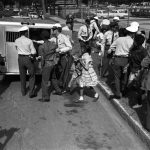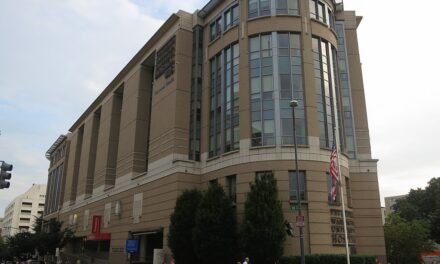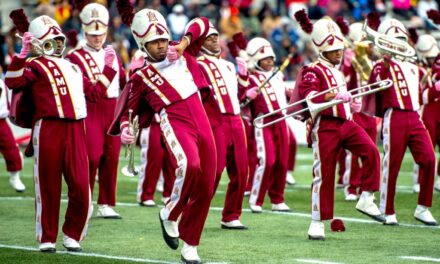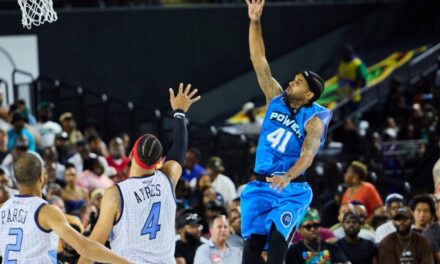Police officers arresting young Civil Rights demonstrators during the Children’s Crusade in Birmingham, Alabama. (Alabama Department of Archives and History. Donated by Alabama Media Group. Photo by Norman Dean)
” data-medium-file=”https://www.birminghamtimes.com/wp-content/uploads/2023/12/BN0004116_06-300×203.jpg” data-large-file=”https://www.birminghamtimes.com/wp-content/uploads/2023/12/BN0004116_06-1024×692.jpg” />
The Birmingham Times
Many events shaped 1963 into a transformative year for Birmingham. Here are some milestones 60 years later as 2023 comes to a close:
Friday, January 11
Contracts signed to begin construction of the multimillion-dollar Red Mountain Expressway; the first phase of the project will take fifteen to eighteen months to complete.
Monday, January 14
George C. Wallace takes over as Alabama governor. During his inaugural he calls for “segregation now … segregation tomorrow … segregation forever!”
Friday, February 15
An injunction petition is filed against the Birmingham Election Commission in Circuit Court to halt the upcoming March 5 Birmingham election.
Wednesday, February 20
Birmingham Mayor Arthur J. Hanes loses his bid to stop the March 5 mayor-council city election.
Tuesday, March 5
In the mayoral election, former Alabama Lt. Gov. Albert Boutwell receives 39 percent of the vote and Birmingham Commissioner of Public Safety Theophilus Eugene “Bull” Connor receives 31 percent, setting up an April 2 runoff.
Sunday, March 24
A heavy explosion heard over much of Birmingham destroys a Black residence, injuring at least two people and damaging houses and other buildings over a two-block radius.
Sunday, March 31
Birmingham Transit Co. operators and maintenance workers vote to go on strike; the Amalgamated Association of Street, Electric, Railway, and Motor Coach Employees of America, Division 725 vote 274 to 117 in favor of the strike.
Tuesday, April 2
Boutwell decisively defeats Connor in the mayoral race; unofficial returns from the city’s 151 boxes show that Boutwell takes 29,630 votes to 21,648 for Connor.
Wednesday, April 3
The Alabama Christian Movement for Human Rights (ACMHR) and the Southern Christian Leadership Council (SCLC) lead sit-in demonstrations at downtown Birmingham lunch counters; twenty participants are arrested at Britt’s lunch counters, while Kress, Loveman’s, Pizitz, and Woolworth’s close their counters.
Friday, April 5
Ten sit-in demonstrators are arrested, including six at Lane Drugstore (First Avenue and 20th Street) and four at Tutwiler Drugstore (Fifth Avenue and 20th Street).
Saturday, April 6
The Rev. Fred Shuttlesworth leads a march toward City Hall, beginning at the A. G. Gaston Motel; police halt the march at 18th Street and Fifth Avenue, arresting thirty-two participants.
Sunday April 7 (Palm Sunday)
The Rev. A. D. King, the Rev. Nelson Smith, and the Rev. John Porter lead a march beginning at St. Paul Methodist Church (Sixth Avenue and 15th Street); police dogs are used to disperse Black onlookers.
Wednesday, April 10
Sit-ins are attempted, but lunch counters are closed; police arrest twenty-seven protesters in the 400 block of 19th Street.
Thursday, April 11
The Rev. Dr. Martin Luther King Jr. and other leaders receive a court-ordered injunction against “boycotting, trespassing, parading, picketing, sit-ins, kneel-ins, wade-ins, and inciting or encouraging such acts.”
Friday, April 12 (Good Friday)
Dr. King, the Rev. Ralph Abernathy, and Shuttlesworth lead a march in defiance of the injunction and are arrested within yards of the site of the Palm Sunday arrests. During his incarceration for this offense, Dr. King writes his “Letter from Birmingham Jail.”
Sunday, April 14 (Easter)
Blacks attend worship services at predominantly white churches and are turned away from several other churches. Approximately one thousand people attempt to march to City Hall but are stopped by police; thirty-two are arrested.
Wednesday, April 17
A local pastor and fifteen Black women march from the Sixteenth Street Baptist Church to the Jefferson County Courthouse to register to vote; they are arrested in the 1600 block of Sixth Avenue.
Wednesday April 17
Birmingham City Council members, meeting in their second session, transfer all authority of the “former city commissioners” to themselves. The three commissioners refuse to leave, contend that they are still the official government, and ignore the council.
Thursday, April 18
Demonstrators stage two sit-ins at lunch counters: one of the facilities is closed, and demonstrators are not served at the other.
Friday, April 19
Eleven protesters are arrested at the 2121 Building lunch counter.
Saturday, April 20
Seven picketers outside the Pizitz lunch counter are arrested. Seven protesters are arrested at a sit-in at Britt’s. Four people are arrested inside Atlantic Mills. And seven people are arrested inside at Tillman Levenson.
Sunday, April 21
Fifteen Black worshippers attend white church services; others are turned away.
Monday, April 22
Sit-ins take place at the Woolworth’s, H. L. Green, and Britt’s lunch counters. Demonstrators are not served, and no arrests are made.
Monday, April 22
Presiding Judge J. Edgar Bowron hears a suit by Birmingham’s new mayor and city council members seeking to oust the city commissioners.
Tuesday, April 23
Bowron rules in favor of Boutwell, saying the newly elected mayor and the nine recently elected council members are the legal city government.
Wednesday, April 24 through Wednesday, May 1
Sporadic demonstrations take place. Protesters spend much of their energy in the courtroom, fighting the injunction and contempt-of-court charges. Mass meetings continue at various churches.
Friday, April 26
Striking Birmingham Transit Co. bus drivers vote 201 to 162 to go back to work.
Wednesday, May 1
Judge William Jenkins hands down sentences for five days in jail and $50 fines for eleven leaders held in contempt of court for ignoring his April 11 injunction.
Thursday, May 2
Children demonstrate en masse against the Birmingham Police Department and Commissioner Bull Connor. Nearly one thousand children are arrested, most in groups ranging in size from thirty to sixty.
Friday, May 3 and Saturday, May 4
Demonstrations involving children continue. Connor responds with police dogs and water hoses, infuriating demonstrators and onlookers.
Sunday, May 5
A mass rally is held at the New Pilgrim Baptist Church (Sixth Avenue and 10th Street South). The rally culminates with a march to the Southside jail and a massive demonstration in Memorial Park across from the jail.
Monday, May 6
Several groups of children and adults that had assembled at the Sixteenth Street Baptist Church are arrested.
Tuesday, May 7
Children continue to demonstrate. Shuttlesworth is hospitalized with injuries inflicted by high-powered water hoses on the steps on the Sixteenth Street Baptist Church.
Wednesday, May 8
Demonstrations are suspended. Movement leaders say white business leaders are acting in good faith to settle issues of concern.
Friday, May 10
Leaders of the demonstrations, represented by Dr. King, and the white business community, represented by Sidney Smyer, reach an agreement including an end to demonstrations and a cooling-off period.
Saturday, May 11
The A. G. Gaston Motel and the home of the Rev. Alfred Daniel (A.D.) King are bombed. Three people are injured in the Gaston Motel explosion. King’s family escapes injury.
Sunday, May 12
President John Fitzgerald Kennedy sends U.S. troops trained in riot control to military bases near Birmingham and pledges that the federal government will “do whatever must be done” to preserve order in the strife-torn city.
Monday, May 20
The Birmingham Board of Education issues an order directing the expulsion of 1,081 Black students arrested in Birmingham racial demonstrations.
Wednesday, May 22
A federal judge rules that the children were illegally expelled and orders the student demonstrators to return to class.
Thursday, May 23
Alabama Supreme Court backs Birmingham voters in their decision to change to mayor-council form of government.
Thursday, May 23
More than one thousand Black student demonstrators return to class under a federal judge’s order that they had been illegally expelled.
Tuesday, May 28
U.S. District Judge Seybourn H. Lynne refuses to order desegregation of Birmingham schools.
Tuesday, June 11
Federal troops head to the University of Alabama to enforce enrollment of two Blacks as Gov. Wallace “stands in the schoolhouse door.”
Wednesday, June 19
Local police and helmeted state troopers, using nightsticks and electric cattle prods, move in Gadsden and disperse more than three hundred Black protestors from the courthouse lawn.
Wednesday, June 19
The Birmingham Parks and Recreation Board votes to reopen at least three municipal golf courses by June 29.
Saturday, June 29
Birmingham Police Chief Jamie Moore asks for a $540,000 increase in the police budget for the 1963-1964 fiscal year, emphasizing the heavy load placed on policemen during race-related demonstrations.
Tuesday, July 2
Plans to merge the Bank for Savings and Trust into the Birmingham Trust National Bank are approved by directors of both banks.
Wednesday, July 10
Alabama’s Highway Director serves notice that the state is ready to proceed with construction of the second section of the six-lane, $16 million Red Mountain Expressway.
Friday, July 12
The Fifth U.S. Circuit Court of Appeals orders Birmingham to begin desegregating public schools by fall.
Tuesday, July 16
About two hundred Birmingham citizens answer a challenge from Mayor Boutwell to serve as members of the new Community Affairs Committee.
Tuesday, July 16
A school meeting on desegregation of public schools ends in disorder after some speakers are drowned out.
Friday, July 19
Boutwell presents City Council a $15,050,270 budget for the 1963-1964 fiscal year.
Tuesday, July 23
The Birmingham City Council unanimously repeals all segregation ordinances as provided in the city’s General Code.
Wednesday, July 24
Fourteen hours after a powerful lightning storm rips through the Birmingham area, nine neighborhoods are still without power.
Sunday, July 28
The City Federal Savings and Loan Association moves into its modernized new home in the former Comer Building in downtown Birmingham.
Wednesday, July 31
The U.S. Justice Department files suit against the Jefferson County Board of Registrars requiring the board to instate more than two thousand Black voter applicants who were rejected because they failed county qualification tests.
Saturday, August 3
About three hundred are jailed in Gadsden after law-enforcement officers break up a mass anti-segregation demonstration in downtown streets.
Wednesday, August 7
The Birmingham City Council adopts Mayor Boutwell’s $15 million general fund budget for fiscal year 1963-1964.
Thursday, August 15
A man sets off a tear-gas bomb on the main floor of Loveman’s department store, sending at least twenty-two people to local hospitals.
Monday, August 19
Judge Clarence Allgood approves the Birmingham Board of Education’s desegregation plan, as demanded in by the Fifth Circuit Court of Appeals; the plan is for Birmingham city schools to begin integrating twelfth grade classes.
Tuesday, August 20
A bomb explodes and damages home of attorney Arthur D. Shores; there are no injuries.
Wednesday, August 21
Black attorneys ask for a federal court order requiring the Board of Education to begin desegregation on all grade levels in the fall instead of only the twelfth grade as planned.
Tuesday, August 27
Six buses leave the Sixteenth Street Baptist Church headed for Washington, D.C., to participate in the March on Washington for Jobs and Freedom.
Wednesday, August 28
Dr. King refers to the violence in Alabama in his historic “I Have a Dream” speech, delivered on the steps of the Lincoln Memorial
Friday, August 30
Birmingham School Board attorneys announce that the three schools to be desegregated are West End and Ramsay high schools and Graymont Elementary School; five Blacks are to be enrolled at the schools.
Tuesday, September 3
The Birmingham City Council votes to approve the sale of Birmingham Transit Co., to American Transit Co. of St. Louis.
Wednesday, September 4
Police battle demonstrators at Graymont Elementary School and Ramsay High School, with many protesters waving Confederate flags and anti-desegregation placards.
Wednesday, September 4
For the second time in 15 days, a bomb damages the home attorney Shores; his wife suffers a minor shoulder injury.
Thursday, September 5
The Birmingham Board of Education formally closes three public schools.
Sunday, September 8
Bombers hurl two firebombs at the suburban home of businessman Arthur George (A.G) Gaston.
Monday, September 9
Gov. Wallace bars Blacks from five state schools, which had been ordered by the schools to accept them. Alabama state troopers turn back Blacks in Birmingham, Tuskegee, and Mobile.
Tuesday, September 10
President Kennedy orders the Alabama National Guard federalized and tells Secretary of Defense Robert McNamara to use any of the nation’s armed forces he deemed necessary to enforce school desegregation in Alabama.
Sunday, September 15
The Sixteenth Street Baptist Church is bombed; four girls are killed–14-year-olds Cynthia Wesley, Carole Robertson, and Addie Mae Collins, and 11-year-old Denise McNair. Later that day 16-year-old Johnny Robinson and 13-year-old Virgil Ware are killed. Robinson was killed by a police officer and Ware by a white teenager on a road in Jefferson County.
Tuesday, September 17
Funeral service for Robertson is held at St. John’s A.M.E. Church.
Wednesday, September 18
Funeral service for Wesley, Collins, and McNair is held at Sixth Avenue Baptist Church.
Sunday, October 6
Eighty-eight mostly white civic leaders and residents publish a full-page ad in The Birmingham News asking the mayor and city council to consider the hiring of Black policemen.
Sunday, October 20
More than 500,000 Jefferson County citizens participate in the first of the Sabin Oral Sundays to strike a blow against paralytic polio.
Sunday October 20
One-hundred-sixteen Black residents publish a full-page ad in The Birmingham News, titled “Birmingham’s Moment of Crisis: A Statement of Concern and Conviction,” asking for the city to take action in several areas to address the tense racial climate.
Tuesday, October 22
City officials reject proposals for hiring Black policemen.
Friday, November 22
President Kennedy is assassinated in Dallas.
Monday, November 25
Birmingham city offices and churches join in a final formal tribute President Kennedy.
Friday, December 13
State officials announce an agreement to begin immediate construction of the Red Mountain Expressway bridge over 21st Street.
Monday, December 23
Six Black children, ranging in age from seven months to six years, die in a fire that raged through their home in Collegeville.
Wednesday, December 25
A 14-year-old Woodlawn High School student missing for two days is found frozen to death in an open ditch near Eastwood Mall. The death was from a fall and exposure to the elements, although an autopsy was ordered.











